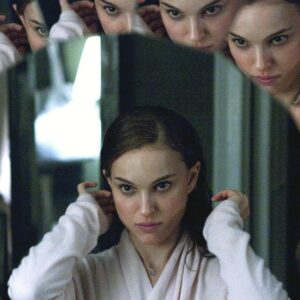
PLOT: Ballet dancer Nina’s (Natalie Portman) life is consumed with her art. She’s smothered by her overbearing mother (Barbara Hershey) and spends every waking moment striving for perfection. When the head of the dance company (Vincent Cassel) needs to replace his prima ballerina (Winona Ryder) in SWAN LAKE, Nina is his first choice. Nina embodies the fragility and innocence of the White Swan but she can’t seem to let go enough to feel the dark sensuality of the other side of the Swan Queen, the Black Swan. When new dancer Lily (Mila Kunis) threatens to take the role away, it sends Nina down a dark path of self discovery that threatens to destroy her.
REVIEW: BLACK SWAN isn’t just a film about ballet. And despite every single story about the film giving an insane amount of coverage to the lesbian sex scene, it isn’t about relationships. BLACK SWAN is a gorgeous story about control. Holding on to it. Letting it go. It’s about the fear of what happens when you unlock one part of yourself. What else flies out the door you’ve opened just a crack? If you give up control over one thing, do you lose control over everything else? From the first moment we get a glimpse of Nina out of pointe shoes, we see her feet facing the wrong way in the bathroom, indicating an eating disorder. And as we arm chair psychologists know, that’s all about control. Nina controls food intake…and outtake. She controls every muscle in her body in the quest for dance perfection. She controls her emotions around her smothering mother, keeping herself in a child-like state so as not to challenge the woman who gave up a dance career to have her. After years of guilt trips about what she could have had if not for Nina, the poor girl has made an art of keeping mom happy with unspoken rules. Stay a child, with a child’s sweetness and obedience. Keep a very pink bedroom full of stuffed animals. Let mommy take care of all your little booboos. And never, never let her see the sexual/adult side of yourself.

The ballet world is all about perfection. It’s full of strictly controlled movements and takes a lifetime of dedication and pain to master. When Nina is forced to tap into her adult desires to keep the role of the Swan Queen, she opens the door a crack. After years of pent up frustration, it all comes spilling out in dark and twisted ways. It literally bursts through her skin. (An excellent exaggeration of Nina’s habit of scratching herself.) Portman’s performance is beautifully multi-layered. You don’t just see a girl suffering from the need to be perfect. You feel the guilt and repressed anger towards her mother. You see her desperate need to be special when she’s chosen for the role and given the attention of the ballet director. You see a woman who has allowed herself to be swayed by whatever wind blows in her direction in an attempt to be non-threatening to her mother. You can almost her her thoughts as she dances. ‘Focus on the movement. Nothing else. Feel nothing else.’ When the adult Nina starts to emerge, it’s so uncomfortable and foreign to her, she projects it onto a fellow dancer, beautifully played by Kunis. In fact, the much talked about lesbian scene is more about merging the two parts of Nina than any particular attraction. Of course I get why it’s gotten so much attention. We all know they’re hot and it’s certainly getting the film extra press. But in a way, it’s a shame. It’s about so much more than that.
Every shot in Aronofsky’s beautiful film is a close up of either keeping things under control or letting control slip away. From Nina wrapping her toes to keep them from bleeding through her pointe shoes, to seeing splintered visuals of herself in the mirror to the scarf that’s always around her neck, she’s wrapped up tight. Even the beautiful costume design shows who these people are. Particularly notable was the scene where Nina is presented as the new Swan Queen at a gala. Though her dress shows plenty of skin, it’s made of strips of fabric that wrap/strangle her. Lily is always in dark colors. Her clothing is looser. She moves with a fluidity and dances in an almost lackadaisical way that suggests she could never have the fragility and innocence to play the White Swan. She becomes the perfect frame on which to hang those parts of herself that Nina can’t express. Aronofsky also manages to seamlessly blend the shots of Portman dancing with the moments someone else had to take over. I danced for years (those damn shoes hurt) and it was difficult for me to tell where they made the switch at times. The final performance is just breathtaking in it’s visual statement that perfection can only be achieved when we let go of control.

Aronofsky also beautifully handles the more supernatural aspects of the story. Every pretty shot is connected to an emotional moment. They’re stunning, and more so for the amount of restraint he used. It could have so easily gone over the top. I can say the same thing for Vincent Cassel’s performance as the head of the dance company. He could have been a monster with no change in the lines. Instead, he’s just this side of creepy. He goes to far with his dancers. He manipulates Nina by kissing her, indicating that there could be more, but it’s never heavy handed. With all the press about the more salacious moments in the film and the deserved praise heaped on Portman and Kunis, it would be easy to overlook such restraint. In fact, Hershey and Winona Ryder, who plays ousted ballerina Beth deserve recognition for their beautiful work as well.
The film stuck with me for days after my first viewing. My only issue is that the ballet may not be quite as compelling for someone who squirms during their annual family trip to see THE NUTCRACKER. My viewing companion isn’t exactly a fan of dance and he wasn’t quite as smitten with the film as I was. That aside, I believe this is going to be an Oscar contender. At least for Portman’s performance.





















Follow the JOBLO MOVIE NETWORK
Follow us on YOUTUBE
Follow ARROW IN THE HEAD
Follow AITH on YOUTUBE